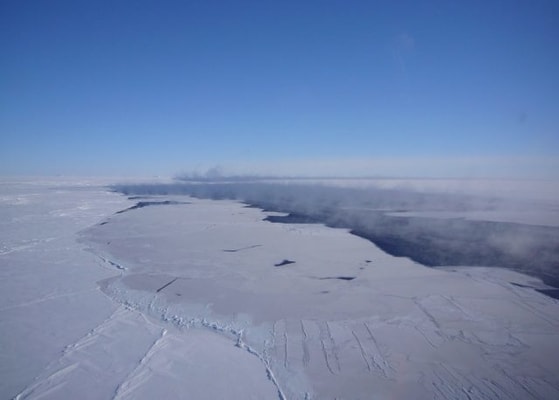
A giant hole has opened up in the ice in Antarctica, and scientists don’t know why. The hole is about the size of Lake Superior and appeared many miles inland from where the ice meets the ocean. Known as a polynya, the hole is extremely puzzling to scientists. The hole was spotted last year for a brief period and hadn’t been seen since the 1970s. It disappeared for several decades before showing up, causing scientists to scratch their head due to the unexplained hole. An unexplained, and reoccurring hole.
The hole measures about 80,000 square kilometres. Scientists first spotted the hole via satellite in the early 1970s, when it opened up for three consecutive winters. Then it disappeared for 40 years. It reappeared for 3 weeks in 2016, and now it’s back. Even bigger than before. It’s been open for four months now, and scientists believe it will remain open for the rest of the winter.
What’s interesting about this discovery is that no one has ever seen it up close. It’s in an extremely remote region of Antarctica’s Weddell Sea. It’s a couple of hundred kilometres away from the coast. Which is what makes this so incredibly fascinating. Polynyas are not uncommon, but they usually only form near the coast. The theory is that ocean currents are lifting warmer waters from the ocean’s depths up to the surface, which is where the ice is melting. The deep water in that part of the Southern Ocean is warmer and saltier than the surface water. Ocean currents bring the warmer water upwards, where it melts the blankets of ice that had formed on the ocean’s surface. That melting created the polynya.

Since the hole continually exposes the water to the atmosphere above, it is difficult for new ice layers to form. When the warmer water cools, on contact with the frigid temperatures in the atmosphere, it sinks. Then it reheats in deeper areas, allowing the cycle to continue. So how is climate change not real?
The Weddell Sea polynya would be like an oasis in the desert for marine mammals such as orcas and seals. Which means it’s probably loaded with life. Scientists have no idea why it’s open now, after being closed for four decades. Or why it’s bigger and longer lasting than ever before. Melting sea ice can be attributed to climate change. Scientists have drawn these conclusions after decades of study and data. Which is why it’s so amazing to me that there are still climate change deniers out there.
The good news is that satellites are much more powerful than they were in the 1970s, so scientists should be able to collect more data this time around. And they plan on studying the region in order to figure out why this is happening. The reason that the hole occurs and then closes might be puzzling to scientists, but the reason for it isn’t. Which is climate change. I don’t know how we can keep denying it when we see its effects every single day. The hole in the Antarctic is just another example of how climate change is real.



